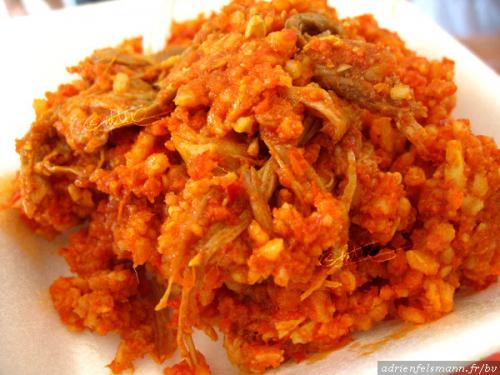
El zacahuil, un platillo tradicional de la huasteca potosina
El zacahuil, un platillo tradicional de la huasteca potosina
Verónica Martínez Venancio y Alfredo Lara Álvarez

An zacahuil juni k´apnél biyal t´ajbilab ti in tsabálil an tének
Juni exbadh k´apnél abal an ajibalchik an tének, nixe´ jats, an tsabál abal ki in bats´uw an alwa´ k´ojoxtalab. An zacahuil pel juni biyal t´ajbilab ma ti owatits , junti jant´idha u exlab ti an biyaltalab u ts´ejkabak i t´ulek inik, po tam ti ulits an lab inikchik jalk´uyat an k´al i t´ulek ko´nél, ma ti xowé´k´ij, u t´ajnaleyej axé´ xi biyal t´ajbiláb.
Ok´oxak, juni jól ti ál an tsabál u ts´ejkabak abal ka tek´dha an zacahuil, po xowe´ jalk´unének we´, kom ts´ejkab k´al juni jorno ts´ejkadh ti lukuk ani tom o ladrillos, ani u eyendhab an dhi´ kom juni biyal eyendhanél ani ti laju´ ma ti laju´tsáb ti k´ij ka aychij , abal ka tek´ets alwa´..
An zacahuil u bijnab k´al an ajib, jats religiosa, o ti juni yanéltalab ani xowé´k´ij ti an bichowchik ti an tsabál an ténekchik, pelits juni t´ajbilab a xi ets´ey u nujuwab k´al axé´ i biyaltalab k´apnél.
A xi u jólchinal, jats an k´oyej, an tsak its, an t´ulek olom o pita´, ani tam u xaluwáb , u dhu´bayab k´al an dhúlup, ani u maliyab k´al an almbre ani tam talnek´its , u otsuwab k´al an jorno, ani jats kwalits ka k´wajiy k´ak´k´al an k´álul
Tam k´wajatits altaj an zacahuil, u paxk´iyab k´al an ts´ejkadh lukuk, abal antsana´ yab ka kalej a xi k´ak in t´ajál, ani tam wat´enekits an k´ij u kadhabita an pulik kwatsám, junti u eyendhab an te´ batella, ani u nedhab k´al an k´wajtalab junti jats ne´ets ka japiyat ani ya bk´wat k´al xi kanidhchik abal ka kapuwat axé´ i kújuw k´apnél xi jats ti tál ti in tsabálil an tének. (TENEK)
email. veromtzv00@gmail.com
El zacahuil, un platillo tradicional de la huasteca potosina
Un platillo importante para las celebraciones de los huastecos, entre ellas, a la madre tierra, para recibir buenas cosechas. El zacahuil ha sido una tradición desde los tiempos prehispánicos, donde históricamente se sabe que era utilizaba la carne humana, pero que con la llegada de los españoles fue remplazada con carne de animal, actividad que hasta hoy en día, se ha conservado como una gran tradición.
Anteriormente, un hoyo bajo la tierra era cavado para cocer el zacahuil, pero hoy en día se ha realizado un cambio, siendo elaborado en un horno hecho de barro y zacate o ladrillos, utilizando como proceso tradicional la leña y que con alrededor de 10 a 12horas de espera, termina su cocimiento.
El zacahuil se ofrece en las fiestas, ya sean religiosas, o familiares y actualmente en los pueblos en la región huasteca potosina, es ya una costumbre la venta de este platillo de tradición ancestral.
Como ingredientes, se utilizan la masa, el chile rojo, la carne de puerco o de pollo, y una vez mezclados, se envuelven con las hojas de plátano, y se amarran con un alambre; una vez terminado, es introducido al horno, el cual ya debe de estar preparado con las brasas ardiendo.
Una vez colocado dentro el zacahuil, es tapado con barro, a fin de que no se escape el calor y una vez transcurrido el tiempo, se saca el tamal grande, ocupando un recipiente hecho de madera, y llevado al lugar en donde podrá ser abierto y repartido a los invitados para que puedan disfrutar de este rico plato originario de la Huasteca Potosina. (ESPAÑOL)
The "Zacahuil": A traditional dish from the Huasteca Potosina
The "Zacahuil" is very important on the celebrations of the Huastecos People, being one of them, the festivity to the mother earth, so they can earn a good harvest. The "Zacahuil" has been a tradition since pre-Hispanic times, when, according to the history, it is known that human flesh was used as ingredient to cook it, practice that was changed after the Spanish conquerors came to America, replacing the human parts with animal meat, which it is done up to the present.
Back in time, a hole was dig underground to cook the "Zacahuil", but nowadays, a change has been made, being elaborated inside a clay-and-grass oven, using as a traditional process the heating with firewood, waiting for around 10 to 12 hours to be cooked.
The "Zacahuil" is offered on parties, whether they are the religious kind or a family reunion, and currently it has been adopted as a custom, among the people of the Huasteca Region, the selling of this ancestral tradition plate.
As ingredients, it is used dough corn, red chili and pork or chicken meat, mixed altogether to be wrapped with the banana plant leaves and tied around with an iron wire; once it is done, it is introduced into the clay oven, which it has to be preheated with hot coals.
Once the "zacahuil" it is located inside, it is covered with mud so the heat stays inside and after the time has elapsed, the "big tamal or zacahuil" is taken out, using a wooden recipient so it can be transferred where it will be opened and distributed to the guests and then they can enjoy of this delicious plate native of the Huasteca Potosina. (ENGLISH)
emsavalles© 2006 - 2025 Todos los derechos reservados. Queda prohibida la publicación, retransmisión, edición y cualquier otro uso de los contenidos sin previa autorización.
Emsavalles Publicidad, Escontría, 216-A, Zona Centro, Ciudad Valles, S.L.P. Tel:481-382-33-27 y 481-381-72-86. emsavalles@hotmail.com. contabilidad@emsavalles.com
No. de Certificado de Reserva Otorgado por el Instituto Nacional del Derecho de Autor: 04-2021-071615041800-203


